As promised, I finally got my photos from Virtual Worlds 2008 uploaded to Flickr, better late than never, right?
As I went through the images, I tried to remember exactly what about the event left me so.. cold. It wasn’t really the people, I was thrilled to see many friends again, Aldon Huffhines from the Orient Lodge, Dave Elchoness from the Association of Virtual Worlds, Grace McDunnough of Phasing Grace, Kenny Hubble from Loyalist College, and Prokofy Neva of Second Thoughts were welcome sights indeed. No amount of virtual interaction ever replaces real hugs and shared drinks and these are people who inspire me, whose blogs I read and events I attend because I have enormous respect for their intelligence and insights. I’m quite annoyed with myself that I forgot my camera and got no pictures of these friends except for Ken the next day.
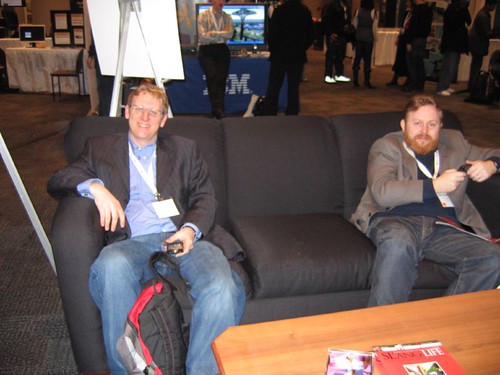
Ken Hudson (SL: Kenny Hubble) on the left.
It was also good to see some folks from Linden Lab in the flesh again, Pathfinder with his ferocious energy and unflagging support of education in Second Life, Betsy who I’d met recently in world, and Ian who does a very wonderful elevator pitch of the Second Life grid branding strategy.

I even spied Philip having a sit down chat with someone in the front of the room (before the Open Source panel, which I’ll talk about later) and he looked more tired than the last time I saw him, but well all the same. It’s a good reminder that the folks at the Lab aren’t all knowing gods, despite what residents would like them to be, but flesh and blood people who get tired and overworked like the rest of us.
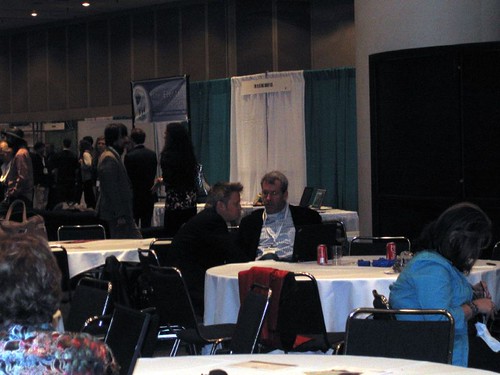
Good too to see the folks from Metaversatility, a name that seemed more apt than ever given the number of platforms, worlds, and offerings on display at the expo.

And great to talk with the folks at VastPark, who actually remembered me from the beta test of a few weeks prior, and who were quite enthusiastic about their plans for open beta and new parks for us to explore. I met some of them later at the SLCN.tv party in the New Yorker hotel and that was quite a bit of fun.
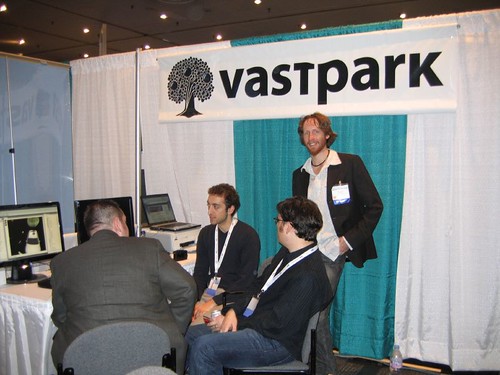
So why then did I eventually leave Virtual Worlds 2008 with a colder heart than I had when arrived? I can’t quite put my finger on it. A couple of years ago I would have been thrilled to think of a room full of booths offering a variety of platforms, services, and tools for virtual worlds users. Back then, I was one of those evangelizing educators that Gwynneth Llewelyn mentions in her latest post, excited by the possibilities, fighting to get Second Life recognized as a legitimate place for educators to explore, research, and teach in, and I’ve since brought literally thousands of educators, students, and friends into the world and continue to do so. But for the first time since my wild ride with Second Life began, I feel.. hesitant. I’m still giving the talks and workshops and bootcamps, I’m still the driving force behind the SL project at my university, and working to increase collaboration in SL among educators in the state of Ohio, but after returning from NYC, I have a heavy sense of foreboding.
The first chill came when I was talking with Grace about the fact that Interoperability was no where to be seen on the agenda. As I explore each new world and work to recreate yet another Fleep (if the name isn’t taken, the internet suddenly seems to have more Fleeps than when I was born), I’m reminded of how _tedious_ it is that I cannot take my avatar from place to place, that I have to re-brand and re-create in each location, re-buy clothes to project the right image (in case I want to demo it at work, these teen worlds seem full of inappropriate for work clothes too), re-build my home, apartment, space.. I do not have the time for all of this duplication of effort. Interoperability is KEY to the success of the metaverse, everyone agrees.
But wait! Sibley from Electric Sheep was there at Virtual Worlds 2008 to tell us that the Metaverse is.. well not dead exactly, but it ain’t going to be here any time soon. More depressing chill. If you’re a fellow VW traveler, philosopher, and junkie like I am, then be sure to check out his slides from the presentation and subscribe to his blog, he promised at the conference that there would be more to come there soon as he continues to think out loud about the future of virtual worlds.
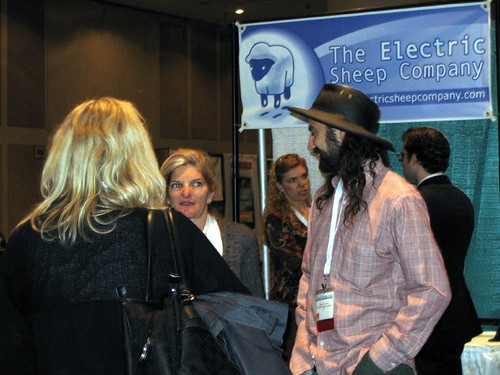
The long and short of his talk, though, was that the steps needed to make the metaverse a reality is extremely messy stuff. The technical hurdles alone are complex and complicated, but the _social_ changes are perhaps even more challenging. The Electric Sheep Company is without a doubt a leader on the cutting bleeding edge, and much of what he said had the ring of truth to it. The bring you back to earth, stop being such an idealistic Pollyana, cold hard reality ring of truth. Thanks, Sibley, for ripping the rose colored glasses from my face. 😉
But truly, all I had to do was look around the room to see the truth of what he was saying. Here I was in Manhattan, attending an event that darn near broke my travel budget bank, surrounded by suits and hawk nosed business types talking about the “compulsion cycle” by which a developer can keep a users eyes glued to the screen, becoming ever more brand loyal, and always buying more stuff – virtual or otherwise.
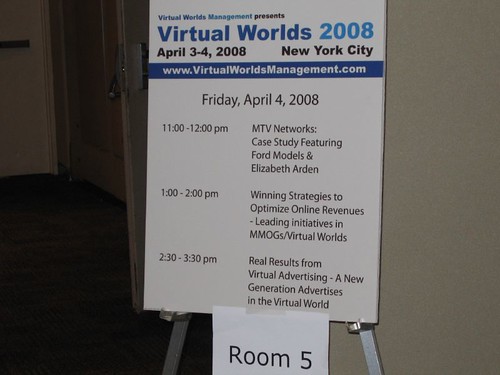
Grace called Interoperability the belle of the last Virtual Worlds ball, but this year’s belle sounded an awful lot like “exploiting kids” to me. Nickelodeon, MTV, and Mattel talked about how to get past moms as gatekeepers (a fellow from Whyville spoke up and said in his experience, there ARE no gatekeepers, parents using PCs as baby sitters aren’t even aware of what their kids are doing in Whyville unless the KID brings the parents into contact with it – remember when you liked your parents and wanted them to come play with you?), talked about how to capitalize on the fact that parents think ANYTHING interactive must be more educational than sitting in front of the boob-tube (an assumption that I think needs some serious examining), and how best to advertise all of their many many “properties” – virtual and real, television and toys, games and brands to these young consumers, how to get the parents’ credit cards linked, how to monetize and exploit this dream (delusion?) I’ve been working so hard to build.
The lawyers were there too, to advise developers, not users. Benjamin Duranske of the Virtually Blind blog about legal issues in virtual worlds was there, looking young, smart, chic, and passionate. While I thought his presentation was actually pretty balanced in terms of developers vs users rights, his theme like the other virtual law sessions I attended boiled down to developers protecting themselves. Questions like, do developers have a responsibility to try to prevent fraud? Should users have rights to their creations in these worlds? Should players who cheat in game worlds be prosecuted? Should companies settle disputes between users or residents? Overall the answer appeared to be that the more a developer interferes in the virtual world, the greater their liability, therefore best to act like a phone company or ISP to better protect oneself from litigation. Very little talk of self governance mechanisms, very little talk of protecting users rights, very little talk of the implications these decisions have on community, on creativity and innovation, on the future of the metaverse.
Education was entirely absent from the Virtual Worlds 2008 roster. I ran into some fellow academic types like Kenny Hubble, but we had no place on the agenda. In one of the kids worlds panels, I heard one woman talk about the educational content of some of these games, but I think that was it other than the Second Life folks talking about the success of education in their world. No where in the kids worlds sessions did I hear about how to incorporate education into all those hours they hope to replace the Saturday morning cartoon with, I didn’t meet any educators working with these developers, I didn’t see any evidence that any of the companies there plan to incorporate any social good beyond being better consumers into their products – sorry, “experiences”. Where on earth were the colleges and universities, the professors and researchers, at Virtual Worlds 2008? Where were the philosophers and those interested in issues of self governance and user rights and non-profit uses and activists and all the people working to extend the positive social benefits of virtual worlds to the real world? Other than the folks I mentioned at the outset, I didn’t see them.
Truly, it was so chilling.
All was not lost, though, the very last session I attended end up being in many ways the highlight of the conference for me. The Open Source Virtual Worlds panel had representatives from Qwaq, Sun’s Project Wonderland, and three fellows working on Open Sim projects.
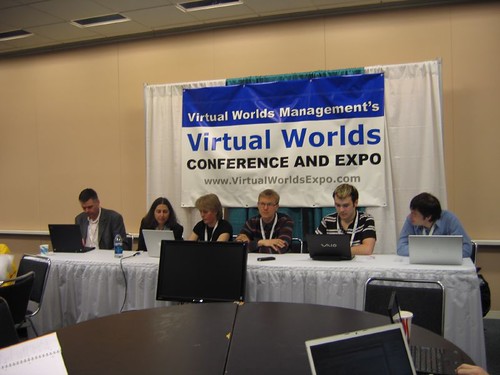
Qwaq and Sun are both focusing on a business and educational market, and I was glad to hear _someone_ talking about the kinds of things I came to hear, like technical implementations that might help enhance collaboration in virtual worlds. The Sun demo was particularly interesting, it seems they’ve done quite a bit of work on how to effectively integrate audio and voice (SL Voice users know how dicey it is), and we saw how a meeting taking place in the virtual world could “call out” to someone on a cell phone and bring them into the conversation. The phone user was represented by an orb that could be “picked up” and carried by another person in world – effectively transferring the call from the group conference to a private conversation – and then “dropped off” on another user in world, again transferring the call to another person. This visual representation (quasi-avatar?) of a phone-based participant in a virtual world conference/meeting opens up interesting possibilities, and it made me quite anxious to check out the Wonderland project.
But more importantly than the demos, it was the conversation that erupted in the middle of the Open Source panel that saved the Virtual Worlds 2008 expo experience for me. Jani Pirkola from realXtend began talking about the work they are doing to make avatar movement more natural, animations that actually detect the doorknob, etc. when from behind me Philip Rosedale of Linden Lab piped up and praised Jani for the work they are doing, since avatar animation is an especially tricky technical problem.
Philip’s mere presence and the substance of what he said seemed to have an electric effect upon the room, suddenly everyone was perked up and at attention. The panel format suddenly turned into a dialogue as audience members jumped in with thoughts and challenges. Zha Ewry of the Architectural Working Group joined a sometimes heated and _competitive_ conversation with Philip and Adam Frisby of OpenSim and Deep Grid about the future of the open source projects, how they will effect virtual economies, and protecting virtual assets.
Funny enough, I actually have a short video of some of this. Somehow the camera got switched to movie mode instead of picture mode, so I inadvertently captured about 50 seconds of the Virtual Worlds 2008 – Open Source Virtual Worlds panel as I fumbled about trying to figure out why the darn flash wasn’t going off. The first segment is part of the demo of Sun’s Project Wonderland, unidentified speaker #2, Philip Rosedale of Linden Lab is speaker #3, Zha Ewry of the Architectural Working Group is #4 (I think), and Adam Frisby of Open Sim is speaker #5.
I don’t know if you can tell by those clips how much energy was in that conversation, but it was the only time outside of the private conversations with friends that the trip to New York felt _worth it_ to me. It was exciting to hear evidence of the debates that must be raging between all these developers, enthusiasts, professionals, and geeks about how exactly these virtual worlds will be implemented. One step at a time for each project, but so many projects and worlds being developed simultaneously, that it’s hard to wrap your mind around just how much work is taking place behind the scenes already, and we’re just in the first few seconds of this Brave New World.
But even then, in the bit of excitement and hope and positive energy I felt at the end, there was reason to feel the Big Chill that permeated the expo for me. Prokofy has often spoken of the dangers we face in these early days of virtual worlds and metaverse dreams and in the excited voices of these boys and men, I heard the architects of my worlds talking of code that is literally transformed into law WITHIN the worlds regardless of what the law might say OUTSIDE the world – I can not give someone a no copy, no transfer object in Second Life under any circumstance because the law of the code prevents me from doing so – and I wondered who was talking with them about the _social and cultural_ implications of their decisions. Even I, one who has just spent the last two years almost entirely devoted to exploring virtual worlds, could barely follow the conversation and technical jargon to grasp at what the outcome of their debate might mean to me, or to a professor, or a university.
In the end I’m not sure what to make of it all. I was very very glad to see my friends and there were bright spots in those few days, but I came back to overflowing inboxes with seemingly hundreds of requests for information or speaking engagements or workshops about Second Life and I can’t help but see them all in a new, far more cynical light. I think Virtual Worlds 2008 ended my Virtual Worlds Honeymoon, and that makes me sad indeed. I already feel that I’ve been working my tail off but I guess now is the time when we must really roll up our sleeves, figure out how to make these virtual worlds work, technically and socially, smush them into the Metaverse we dreamt of, still lead a balanced Real Life, make it financially worthwhile without selling out our souls to MTV, and continue to work on figuring out how these virtual worlds can make our real one a better place, for ourselves AND our kids, who hopefully will be learning more than just better brand loyalty in the worlds we create.
We have a _lot_ of work to do.
Hi Fleep: It was great to see you too and I enjoyed our chat very much. I agree with you: a mixed bag for sure. One thing you missed: my brief talk about employment in virtual worlds. Definitely about the ‘user’, i.e. being entitled to real life legal protections despite the ‘virtual’ nature of the job. So a guy sitting in his real life kitchen building a sim with another friendly avatar *could be* unintentionally taking on the obligations of an international employer (think wages, tax, pension, etc.) Interesting stuff. Take a look at Digado’s blog for a video done on the Double Happiness experiment — “virtual sweatshop.”
Yes the conversation at the Open Source Virtual Worlds was very, very interesting. I have posted a full transcription of the discussion on Ugotrade and an audio recording. The audio is not very high quality because the “round tables” were a last minute “unconference” addition to Virtual Worlds 2008, and we were not provided with any media, recording or monitors for demoing. I brought the monitor sitting on the chair in from my home office!! But Fleep is right the discussion was absolutely first class, and the room was packed (even though we were not in the schedule!) and many of the key players in the open source metaverse including Philip and Ginsu from Linden Lab were there!
Thanks for the report from the front lines, Fleep.
I like getting different, independent perspectives like yours, Gwyn’s and Prokofy’s on the state of virtual affairs. You each have different points of view and some history to look back on that makes your opinions valuable.
I think a short period of rest and recuperation might be in order, no need to carry the world on your shoulders. And keep in mind that great bit of dialogue delivered by Bette Davis, “Fasten your seatbelts. It’s going to be a bumpy ride.”
Help a novice understand why it’s important to have avatars with more “natural” movements and with more “business-appropriate” clothing choices…I guess I can understand the clothing thing because clothing projects persona, but how do movements come into play here? And I wonder if we aren’t limiting the possibilities of virtual worlds when we work so hard to make them so similar to our first one.
I’m sure these comments seem completely elementary to your savvy readers, but many of us are slow at coming to Second Life (and other virtual worlds), and we can’t quite grasp the ramifications of these seemingly important conversations.